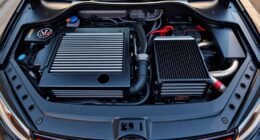To maximize your 2007 Ford Mustang's power, start with a cold air intake and a BAMA Performance 93 race tune to boost airflow and efficiency. Consider adding an off-road exhaust system for enhanced sound and flow. Upgrading your gear ratio to 4.10 improves acceleration, giving you a thrilling 0-60 time. For serious power, a Stage 2 supercharger can push your output to 320-325 rwhp. Don't overlook handling upgrades like lowering springs and sway bars for better stability. With the right mods and tuning, your Mustang will roar on the road—there's plenty more to explore on achieving peak performance.
Key Takeaways
- Upgrade to a BAMA Performance 93 Race Tune to optimize power and efficiency after installing a cold air intake.
- Install a Stage 2 supercharger for achievable power gains of 320-325 rwhp and improved acceleration.
- Enhance exhaust flow with a Pypes Off-Road X-Pipe and axle-back system for better performance and sound.
- Lowering springs and sway bars improve handling, reduce body roll, and enhance cornering stability.
- Engage in custom tuning and data logging to maximize performance gains and ensure engine safety post-modifications.
Initial Performance Assessment
When evaluating the 2007 Mustang GT's initial performance, you'll find it starts strong with a stock output of 300 horsepower and 320 lb-ft of torque.
However, a dyno run reveals that at the rear wheels, it drops to 259 horsepower and 282 lb-ft, indicating some loss through the drivetrain. This baseline sets the stage for potential improvements.
To access more power, you might consider adding a Cold Air Intake, like the Airaid Race model, which can enhance airflow and engine efficiency.
You'll also need to tune your Mustang afterward, such as with a BAMA Performance 93 race tune, to maximize the benefits of your intake upgrade. Together, these modifications can push performance to around 294 horsepower and 309 lb-ft of torque.
If you're looking for quicker acceleration, changing the gear ratio to 4.10 can greatly improve low-end response, making your 0-60 time of 5.5 seconds feel even more exhilarating.
Pairing these upgrades with performance tires will enhance grip, ensuring that all that power translates effectively to the road. Each tweak brings you closer to achieving your performance goals.
Key Modifications Overview

To release the full potential of your 2007 Mustang GT, several key modifications can make a substantial difference in performance and drivability.
By focusing on both airflow and exhaust enhancements, you can achieve impressive gains in horsepower and torque.
Here's a quick overview of essential upgrades:
- BAMA Performance 93 Race Tune: Optimizes engine power output and efficiency.
- Airaid Race Cold Air Intake: Improves airflow, leading to increased horsepower, especially when paired with a performance tune.
- Pypes Off-Road X-Pipe and Axle-Back System: Enhances exhaust flow and sound, making your Mustang GT's roar more aggressive.
- Stock Gear Ratio Upgrade (3.55 to 4.10): Boosts low-end acceleration, making your car more responsive off the line.
- Lowering Springs: Improves handling and lowers the center of gravity for better stability.
After implementing these modifications, consider a dyno run to measure your gains.
It's not uncommon to see an increase of up to 35 horsepower and improved torque figures, taking your Mustang GT to the next level of performance.
Target Power Goals

Setting clear target power goals for your 2007 Mustang GT is vital if you're aiming for serious performance gains. Aiming for 400-450 horsepower from a naturally aspirated setup is ambitious but achievable with the right modifications. You'll likely need to evaluate upgrades like performance cams and long tube headers to support high horsepower.
Here's a quick overview to visualize your goals:
| Power Output | Modifications Required | Performance Benchmark |
|---|---|---|
| 320-325 rwhp | Stage 2 supercharger + tune | 0-60 time ~4 seconds |
| 400-450 rwhp | Internal engine upgrades + nitrous | 0-60 time under 3 seconds |
| 350-375 rwhp | Cold air intake + exhaust system + tune | 0-60 time ~3.5 seconds |
| 500+ rwhp | Forced induction + extensive internal upgrades | Requires specialized tuning |
| High Torque | Focus on off-the-line performance | Daily drivability |
After any modifications, a thorough tuning session is vital for optimizing performance. With the right setup, your Mustang GT can be a formidable powerhouse, embodying the spirit of Ford Racing.
Forced Induction Options

Forced induction is a game-changer for boosting the horsepower of your 2007 Mustang GT. By adding superchargers or turbochargers, you can notably elevate your car's performance.
Positive displacement superchargers can yield around 320-325 rwhp, while centrifugal superchargers can achieve 330-340 rwhp with proper tuning. Turbo setups are equally effective and can provide similar power levels, making them a solid choice for performance tuning enthusiasts.
When considering forced induction options, keep these key points in mind:
- Confirm compatibility of any supercharger kit with your stock engine.
- A Stage 2 supercharger kit can lead to substantial power gains.
- Turbochargers offer an alternative path to high power levels.
- Performance tuning is essential post-installation to optimize engine output.
- Twin charging (using both supercharger and turbocharger) can lead to immense power increases but requires careful execution.
Essential Engine Upgrades

Upgrading your 2007 Mustang GT's engine with vital components can greatly enhance its performance.
Start with performance cams; they improve airflow and can boost horsepower by 25-40 hp, depending on the camshaft you choose. Pair those with long tube headers to enhance exhaust flow, which can add another 15-20 hp and improve torque delivery across the RPM range.
Consider installing charge motion delete plates as well. These optimize airflow into the intake manifold and are particularly beneficial for supercharged setups, allowing for even more horsepower.
To bring it all together, invest in a quality cold air intake system. This upgrade allows cooler, denser air to enter the engine, often yielding 10-20 hp when paired with a proper tune.
Speaking of tuning, it's essential to properly calibrate your Mustang after these modifications. A well-executed tune can maximize the performance gains from your upgrades, potentially increasing overall output by an additional 10-20%.
Handling Enhancements

To truly elevate your 2007 Mustang GT's performance on the road, handling enhancements are a must. By focusing on suspension upgrades, you can markedly reduce body roll and improve overall stability, making your driving experience more enjoyable and controlled.
Consider these key modifications:
- Upgrade to SR Performance Lowering Springs: Lowering your vehicle by approximately 1.5 inches enhances its center of gravity for better handling dynamics.
- Install Eibach Sway Bars: These will reduce body roll and offer better cornering stability, allowing you to take turns with confidence.
- Add a Strut Tower Brace: This reinforces front-end stability, decreasing chassis flex and improving steering response.
- Use Larger Rear Sway Bars: They can induce oversteer, enhancing cornering performance and allowing for better rotation during aggressive driving.
- Align the Vehicle Post-Installation: Ensuring proper alignment after modifications is vital for ideal handling and even tire wear.
Aesthetic Modifications

After enhancing your Mustang's handling, it's time to give its appearance a boost. Aesthetic modifications can transform your 2007 Mustang GT into a true head-turner. Let's explore some popular options that elevate both style and performance.
| Modification | Description | Benefits |
|---|---|---|
| Raxiom Pre-Painted Bucket Lights | Enhances visibility with a modern retro touch. | Improved visibility and updated look. |
| Matte Black LeMans Stripes | Delivers a classic racecar aesthetic. | Bold visual statement without losing sleekness. |
| MMD Retro-Style Mirrors | Pays homage to iconic 60s and 70s designs. | Nostalgic flair that enhances overall look. |
| Black Staggered Deep Dish Wheels | Aggressive stance with improved performance. | Better grip and striking appearance. |
| SpeedForm Eleanor Style Grille | Transforms the front bumper for a distinctive character. | Enhanced airflow and aggressive styling. |
These Mustang parts not only enhance the overall aesthetic but also improve functionality. Upgrading your tail lights, grille, and wheels can give your Mustang an edge that stands out on the road. Don't hesitate to immerse yourself in these modifications and make your Mustang uniquely yours!
Tuning and Data Logging

When you customize your 2007 Mustang GT, custom tuning becomes essential for maximizing horsepower and torque. In order to fully unleash the potential of your customized 2007 Mustang GT, investing in a custom tuning solution is crucial. Whether you have added performance upgrades such as a cold air intake, exhaust system, or forced induction, a custom tune will ensure that your vehicle is performing at its peak. Similarly, customizing your SUV with aftermarket parts and modifications will also require custom tuning to optimize performance and ensure fuel efficiency.
You'll want to utilize data logging to track key metrics like air-fuel ratios and spark advance, ensuring your modifications perform seamlessly.
Regularly logging data after each upgrade helps you fine-tune your setup for best performance and reliability.
Importance of Custom Tuning
Custom tuning is essential for releasing your Ford Mustang's full potential, especially after adding aftermarket modifications. Without a proper tune, you may not fully realize the horsepower and performance gains that these upgrades can provide. Custom tuning optimizes your engine's air-fuel mixture and ignition timing, directly enhancing horsepower and torque outputs.
Here are some key benefits of custom tuning:
- Reveals the full potential of aftermarket modifications, like cold air intakes and exhaust systems.
- Increases horsepower by 10-20% when done correctly.
- Guarantees your engine operates within safe limits, preventing potential damage.
- Provides convenience with remote tuning options, allowing you to adjust your Mustang's performance without visiting a shop.
- Utilizes reputable tuning shops for expert guidance, enhancing reliability and longevity.
Investing in custom tuning not only boosts your Mustang's performance but also offers peace of mind knowing that your engine is finely tuned to handle the modifications you've made.
Don't settle for mediocre gains; embrace custom tuning to reveal the true power of your modern muscle car. With the right adjustments, you can unlock a whole new level of performance, velocity, and responsiveness. Whether you’re looking for enhanced throttle response, improved fuel efficiency, or raw horsepower, custom tuning is key to making the most of your ride. For those seeking Ford Mustang 2005 tuning tips, start by focusing on optimizing your air intake, upgrading your exhaust system, and fine-tuning your ECU for maximum gains.
Data Logging Essentials
Data logging plays an essential role in the custom tuning process for your Ford Mustang. By connecting your OBD-II port to a laptop using a tuner device and data-logging software, you can capture real-time engine performance data. This data is critical for making informed tuning adjustments that enhance your vehicle's capabilities.
During data logging, you'll want to monitor key parameters such as spark advance, knock sensor readings, air/fuel mix commanded, and O2 sensor outputs. These performance metrics help you identify tuning issues and guarantee your engine runs efficiently after modifications.
The configuration files supplied by tuners determine which sensors are logged, ensuring that the most relevant data is captured for analysis. All S197 Mustangs support data logging, making it a fundamental component of maximizing engine performance.
Budgeting for Upgrades

When budgeting for your 2007 Mustang GT upgrades, focus on cost-effective modifications that deliver the best performance gains.
Prioritize essential parts like a cold air intake and exhaust system to maximize your horsepower without breaking the bank.
Remember to factor in installation costs, as professional help can guarantee your upgrades perform at their best.
Cost-Effective Modifications
If you're looking to enhance your 2007 Ford Mustang without breaking the bank, setting a budget of under $2,000 for initial modifications is a smart move.
This approach allows you to make cost-effective upgrades that considerably boost performance while keeping your finances in check.
Prioritize basic upgrades that yield noticeable horsepower gains, such as:
- Cold air intake: Improved airflow can enhance engine efficiency.
- Performance tune: Optimizes engine parameters for better power output.
- Exhaust system: Increases airflow and adds a sporty sound.
- High-performance spark plugs: Guarantees efficient ignition and combustion.
- Lightweight wheels: Reduces unsprung weight for improved handling.
Before diving into performance mods, confirm you've addressed any existing issues with your Mustang.
A reliable platform is key for future enhancements.
Consider investing in a one-time thorough tuning session after completing your modifications to save on costs compared to multiple individual sessions.
Engaging with community forums can also provide valuable insights into budget modifications and effective strategies for maximizing your Mustang's potential without overspending.
Prioritize Essential Upgrades
To get the most from your budget while tuning your 2007 Ford Mustang, it's crucial to prioritize essential upgrades that deliver the best performance gains.
Start by setting a budget of under $2,000 for impactful modifications. Focus on essential performance mods like a BAMA Performance 93 race tune and an Airaid Race Cold Air Intake. These upgrades alone can yield a significant horsepower boost—up to 35 horsepower in a modified Mustang GT.
Next, consider upgrading your tires and rims early in the modification process. Improved traction and safety will enhance the performance gains from your engine upgrades.
Additionally, a simple gear ratio change from 3.55 to 3.73 can enhance acceleration without breaking the bank, fitting nicely within your budget.
Don't forget to plan for both parts and labor costs, including tuning sessions. This guarantees every upgrade maximizes your vehicle's performance while keeping you within your budget constraints.
Frequently Asked Questions
How Much Horsepower Does a Tune Add to a Mustang?
A tune can boost your Mustang's horsepower by approximately 10-20%, depending on modifications. If you combine it with upgrades like a cold air intake, you might see gains of 30-50 horsepower at the rear wheels.
How Do I Add More Horsepower to My Mustang?
Imagine your Mustang as a caged lion, longing to roar. You can release its power by upgrading the intake, tuning the engine, and enhancing exhaust flow. Each modification lets your beast run wild on the road.
How Can I Make My 2007 V6 Mustang Faster?
To make your 2007 V6 Mustang faster, consider installing a cold air intake, upgrading to a performance exhaust, tuning for 93 octane, changing the gear ratio, and adding performance tires for better traction and acceleration.
How to Get More Power Out of a 3.8 V6 Mustang?
Did you know that a high-performance cold air intake can boost your horsepower by up to 10%? To get more power out of your 3.8 V6 Mustang, consider upgrades like a supercharger or performance exhaust.
Conclusion
To sum up, tuning your 2007 Ford Mustang can transform it into a true beast on the road. With the right upgrades, you'll not only achieve impressive power but also enhance handling and aesthetics. Remember, it's all about finding that sweet spot between performance and style—like cruising down the highway with your favorite mixtape blasting. So, roll up your sleeves and get started; your modern muscle car is ready to roar!










